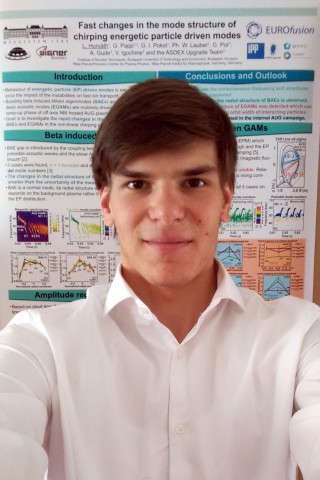Experimental investigation of energetic particle driven modes on ASDEX Upgrade
Report by Laszlo Horvath. Powered by FuseNet
 During the spring of 2015 I spent two months in the Max Planck Institute for Plasma Physics (IPP) in Garching, Germany. IPP Garching is the institute where the ASDEX Upgrade tokamak is operated. This time the institute was very quiet, because this year’s campaign is just started in the summer after my visit. Although, my topic is rather experimental, this time only data processing and theoretical tasks were waiting for me, so this operation-free period of the tokamak was perfect to carry out discussions with the scientists of the institute.
During the spring of 2015 I spent two months in the Max Planck Institute for Plasma Physics (IPP) in Garching, Germany. IPP Garching is the institute where the ASDEX Upgrade tokamak is operated. This time the institute was very quiet, because this year’s campaign is just started in the summer after my visit. Although, my topic is rather experimental, this time only data processing and theoretical tasks were waiting for me, so this operation-free period of the tokamak was perfect to carry out discussions with the scientists of the institute.
It is always amazing to feel the atmosphere of such a huge institute like IPP. The view of the torus hall is very impressive. The control room was almost empty, but one can imagine the bustle during a shot day. Scientists in the institute are open to answer questions, so learning is very effective there. I had several fruitful discussions which helped me to finalize my MSc thesis.
The field of my thesis is related to fast ion driven instabilities. In magnetic confinement fusion devices, it is crucial to confine the high energy ions to maintain the energy equilibrium of the plasma. However, super-thermal energetic ions can excite various instabilities which can lead to their enhanced radial transport. Therefore, the understanding of these modes is a key issue regarding future burning plasma experiments.
In my thesis I investigated the time evolution of the radial structure of different energetic particle driven modes. This analysis has two objectives. One, for specific modes the results could confirm the assumption of codes modelling the wave-particle interaction by retaining the radial structure of the mode. Two, the results can serve as the basis of comparison with non-linear codes which can take the changes of the radial structure into account. At this point there is no quantitative comparison of my results with simulations, but I have shown in my thesis that the experimental results are consistent with the corresponding theory.
The visit was very useful to finish my MSc thesis. And this internship was successful as well, in the sense that my poster – which summarized my thesis and the work done in Garching –received the EPS/PPCF/IUPAP poster prize at the 42nd EPS Conference on Plasma Physics in Lisbon.
